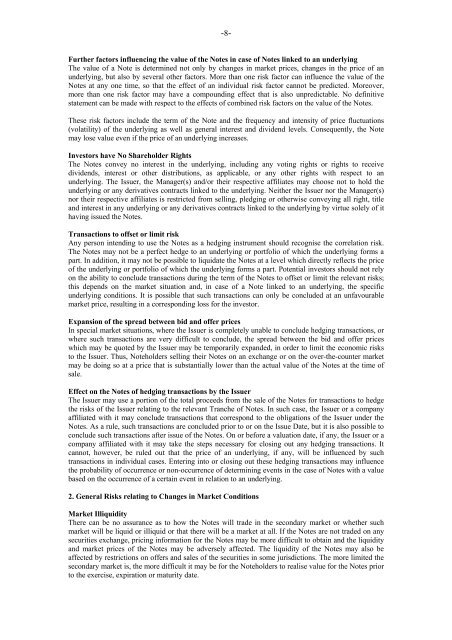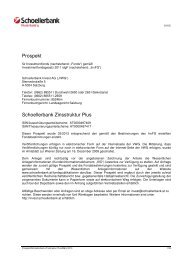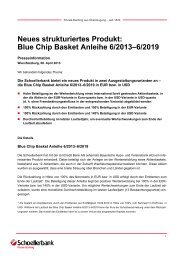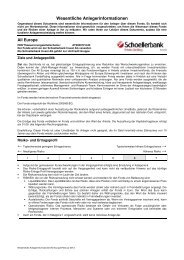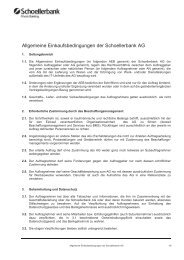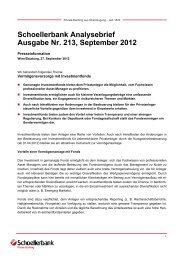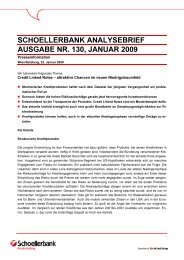BARCLAYS BANK PLC Barclays Capital
BARCLAYS BANK PLC Barclays Capital
BARCLAYS BANK PLC Barclays Capital
Create successful ePaper yourself
Turn your PDF publications into a flip-book with our unique Google optimized e-Paper software.
-8-<br />
Further factors influencing the value of the Notes in case of Notes linked to an underlying<br />
The value of a Note is determined not only by changes in market prices, changes in the price of an<br />
underlying, but also by several other factors. More than one risk factor can influence the value of the<br />
Notes at any one time, so that the effect of an individual risk factor cannot be predicted. Moreover,<br />
more than one risk factor may have a compounding effect that is also unpredictable. No definitive<br />
statement can be made with respect to the effects of combined risk factors on the value of the Notes.<br />
These risk factors include the term of the Note and the frequency and intensity of price fluctuations<br />
(volatility) of the underlying as well as general interest and dividend levels. Consequently, the Note<br />
may lose value even if the price of an underlying increases.<br />
Investors have No Shareholder Rights<br />
The Notes convey no interest in the underlying, including any voting rights or rights to receive<br />
dividends, interest or other distributions, as applicable, or any other rights with respect to an<br />
underlying. The Issuer, the Manager(s) and/or their respective affiliates may choose not to hold the<br />
underlying or any derivatives contracts linked to the underlying. Neither the Issuer nor the Manager(s)<br />
nor their respective affiliates is restricted from selling, pledging or otherwise conveying all right, title<br />
and interest in any underlying or any derivatives contracts linked to the underlying by virtue solely of it<br />
having issued the Notes.<br />
Transactions to offset or limit risk<br />
Any person intending to use the Notes as a hedging instrument should recognise the correlation risk.<br />
The Notes may not be a perfect hedge to an underlying or portfolio of which the underlying forms a<br />
part. In addition, it may not be possible to liquidate the Notes at a level which directly reflects the price<br />
of the underlying or portfolio of which the underlying forms a part. Potential investors should not rely<br />
on the ability to conclude transactions during the term of the Notes to offset or limit the relevant risks;<br />
this depends on the market situation and, in case of a Note linked to an underlying, the specific<br />
underlying conditions. It is possible that such transactions can only be concluded at an unfavourable<br />
market price, resulting in a corresponding loss for the investor.<br />
Expansion of the spread between bid and offer prices<br />
In special market situations, where the Issuer is completely unable to conclude hedging transactions, or<br />
where such transactions are very difficult to conclude, the spread between the bid and offer prices<br />
which may be quoted by the Issuer may be temporarily expanded, in order to limit the economic risks<br />
to the Issuer. Thus, Noteholders selling their Notes on an exchange or on the over-the-counter market<br />
may be doing so at a price that is substantially lower than the actual value of the Notes at the time of<br />
sale.<br />
Effect on the Notes of hedging transactions by the Issuer<br />
The Issuer may use a portion of the total proceeds from the sale of the Notes for transactions to hedge<br />
the risks of the Issuer relating to the relevant Tranche of Notes. In such case, the Issuer or a company<br />
affiliated with it may conclude transactions that correspond to the obligations of the Issuer under the<br />
Notes. As a rule, such transactions are concluded prior to or on the Issue Date, but it is also possible to<br />
conclude such transactions after issue of the Notes. On or before a valuation date, if any, the Issuer or a<br />
company affiliated with it may take the steps necessary for closing out any hedging transactions. It<br />
cannot, however, be ruled out that the price of an underlying, if any, will be influenced by such<br />
transactions in individual cases. Entering into or closing out these hedging transactions may influence<br />
the probability of occurrence or non-occurrence of determining events in the case of Notes with a value<br />
based on the occurrence of a certain event in relation to an underlying.<br />
2. General Risks relating to Changes in Market Conditions<br />
Market Illiquidity<br />
There can be no assurance as to how the Notes will trade in the secondary market or whether such<br />
market will be liquid or illiquid or that there will be a market at all. If the Notes are not traded on any<br />
securities exchange, pricing information for the Notes may be more difficult to obtain and the liquidity<br />
and market prices of the Notes may be adversely affected. The liquidity of the Notes may also be<br />
affected by restrictions on offers and sales of the securities in some jurisdictions. The more limited the<br />
secondary market is, the more difficult it may be for the Noteholders to realise value for the Notes prior<br />
to the exercise, expiration or maturity date.


